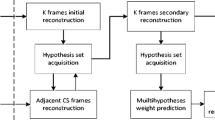Abstract
Compressed sensing (CS) breaks the limit of Nyquist sampling rate and provides a new method for information sampling. Compressed video sensing (CVS) introduces CS into video codec and decreases the burden of encoding. For three-dimensional video data, the cube-based CVS scheme is an intuitive method in that CS measurements can span the entire spatial and temporal extent of a video sequence. Unfortunately, the measuring of multiple frames in video cubes simultaneously requires complex calculation and expensive spatial costs, which is largely considered impractical to implement in a real device. In this paper, a novel compressed video sensing scheme that is exactly suitable for wireless multimedia sensor networks is proposed by changing the method of processing multiple frames in video cubes. At the encoder, sampling rate redistribution (SRR) algorithm increases the measurements contained in the first and last frames so that they can assist to reconstruct intermediate frames. At the decoder, all measurements are scrambled by global measurement scrambling (GMS) algorithm to make them similar to measurements of the global CS acquisition. The experimental results show that the proposed scheme effectively improves the decoding performance on the premise of realizable hardware devices.











Similar content being viewed by others
References
Baraniuk RG (2007) A lecture on compressive sensing. IEEE Signal Process Mag 24(4):118–121
Chambolle A, Lions PL (1997) Image recovery via total variation minimization and related problems. Numer Math 76(2):168–188
Chan TF, Esedoglu S, Park F, Yip A (2006) Total variation image reconstruction: overview and recent developments. In: Paragios N, Chen Y, Faugeras OD (eds) Handbook of mathematical models in computer vision, chap 2. Springer, New York
Coluccia G, Kuiteing SK, Abrardo A, Barni M, Magli E (2012) Progressive compressed sensing and reconstruction of multidimensional signals using hybrid transform/prediction sparsity model. IEEE J Emerging Sel Top Circuits Syst 2(3):340–352
Do TT, Gan L, Nguyen NH, Tran TD (2012) Fast and efficient compressive sensing using structurally random matrices. IEEE Trans Signal Process 60(1):139–154
Donoho D (2006) Compressed sensing. IEEE Trans Inf Theory 52(4):1289–1306
Duarte MF, Baraniuk RG (2012) Kronecker compressive sensing. IEEE Trans Image Process 21(2):494–504
Duarte MF, Davenport MA, Takhar D, Laska JN, Sun T, Kelly KF, Baraniuk RG (2008) Single-pixel imaging via compressive sampling. IEEE Signal Proc Mag 25(2):83–91
Fowler JE, Mun S, Tramel EW (2012) Block-based compressed sensing of images and video. Found Trends® Signal Process 4(4):297–416
Hestenes MR (1969) Multiplier and gradient methods. J Optim Theory Appl 4(5):303–320
Jiang H, Li CB, Haimi-Cohen R, Wilford PA, Zhang Y (2012) Scalable video coding using compressive sensing. Bell Labs Techn J 16(4):149–169
Kang LW, Lu CS (2009) Distributed compressive video sensing. In: IEEE International Conference on Acoustics, Speech and Signal Processing. TaiWan, China, pp 1169–1172
Li CB (2009) An efficient algorithm for total variation regularization with applications to the signal pixel camera and compressive sensing. Master Thesis, Computational and Applied Mathematics, Rice University
Li CB, Jiang H, Wilford P, Zhang Y, Scheutzow M (2013) A new compressive video sensing framework for mobile broadcast. IEEE Trans Broadcast 59(1):197–205
Li CB, Jiang H, Wilford P, Zhang Y (2011) Video coding using compressive sensing for wireless communications. In: Wireless Commun. Networking Conference (WCNC. Cancun, Mexico, pp 2077–2082
Lorintiu O, Liebgott H, Alessandrini M, Bernard O, Friboulet D (2014) Compressed sensing reconstruction of 3D ultrasound data using dictionary learning. In Image Processing (ICIP), 2014 I.E. International Conference. Paris, France, pp. 1317–1321
Powell MJD (1969) A method for nonlinear constraints in minimization problems. Optimization 283–298
Markus L, Marian C, Markku J (2015) Sequential compressed sensing with progressive signal reconstruction in wireless sensor networks. IEEE Trans Wirel Commun 14(3):1536–1276
Mandal MK, Idris F, Panchanathan S (1999) A critical evaluation of image and video indexing techniques in the compressed domain. Image Vis Comput 17(7):513–529
Peaceman DW, Rachford HH (1955) The numerical solution of parabolic and elliptic differential equations. J Soc Ind Appl Math 3:328–41
Reddy D, Sankaranarayanan A, Cevher V, Chellappa R (2008) Compressed sensing for multi-view tracking and 3-d voxel reconstruction. In: 15th IEEE International Conference on Image Processing. San Diego, CA, pp 221–224
Rudin LI, Osher S, Fatemi E (1992) Nonlinear total variation based noise removal algorithms. Physica D Nonlinear Phenomena 60(1–4):259–268
Ying L, Pados DA (2013) Decoding of frame-wise compressed-sensed video via inter-frame total variation minimization. Journal Electron Imaging 22(2):1–8
Zhang YF, Mei SL, Chen QQ, Chen ZB (2008) A multiple description image/video coding method by compressed sensing theory. In: IEEE Int. Symp. on Circuits and Systems. Seattle, Washington, pp. 1830–1833
Zhang YF, Mei SL, Chen QQ, Chen ZB (2008) A novel image/video coding method based on compressed sensing theory. In: IEEE Int. Conf. on acoustics, speech, and signal processing. Las Vegas, Nevada, pp. 1361–1364
Acknowledgments
This work was supported by the National Science Foundation China under grant 61440056 and 61540046, and the 111 Project of China (B08038).
Author information
Authors and Affiliations
Corresponding author
Rights and permissions
About this article
Cite this article
Kuo, Y., Gao, Y., Zhang, X. et al. A new multiple frames decoding and frame wise measurement for compressed video sensing. Multimed Tools Appl 76, 7321–7339 (2017). https://doi.org/10.1007/s11042-016-3390-6
Received:
Revised:
Accepted:
Published:
Issue Date:
DOI: https://doi.org/10.1007/s11042-016-3390-6




